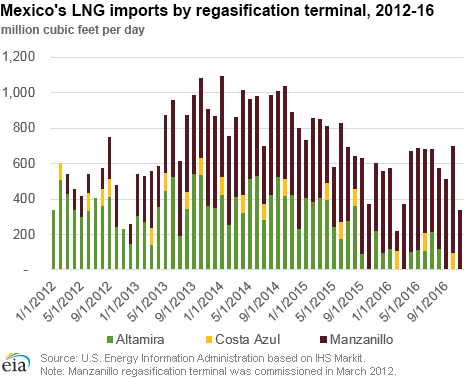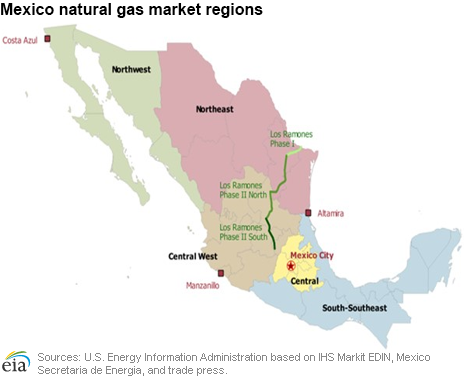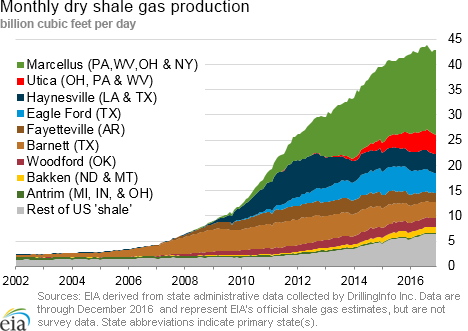In the News:
LNG imports remain high at Mexico's Manzanillo terminal
Mexico's Central region, which includes Mexico City, has increasingly relied on imports of liquefied natural gas (LNG) at the Manzanillo terminal to meet its growing natural gas demand because of bottlenecks on the pipeline system that supplies this region. The Los Ramones Phase II South pipeline, commissioned in July 2016, was expected to alleviate natural gas shortages in the Central region and gradually displace LNG imports at the Manzanillo terminal. However, since the start of partial service, the Los Ramones Phase II South pipeline has reportedly experienced technical problems. Currently, both North and South segments of Phase II of Los Ramones pipeline operate at a capacity of 400 million cubic feet per day (MMcf/d), significantly below the nameplate capacity of 1,430 MMcf/d, according to Mexico's Secretaria de Energia. As a result, the Central region remains dependent on LNG imports to balance its supply.
Manzanillo is the most utilized of Mexico's three regasification terminals. Its unique point of entry on the Pacific coast in the Central West region of Mexico bypasses several domestic pipeline bottlenecks and allows imported natural gas to reach customers in the Central region. In 2016, because of continuous natural gas supply shortages in the region, LNG imports at Manzanillo increased by an average 30% in the second and third quarters, compared with the same periods in 2015, and by 62% in October year-on-year, according to IHS data.
Mexico meets almost half of its natural gas demand with imports. Mexico's pipeline imports from the United States have increased significantly, and in 2015, accounted for 80% of Mexico's natural gas imports. Lower-priced natural gas from the United States is gradually displacing LNG imports, particularly at the Altamira terminal where LNG imports declined by 72% in January–November 2016 compared with the same period last year. With the projected doubling of the U.S. border-crossing pipeline capacity into Mexico over the next two years and the expansions on Mexico's domestic pipeline network, natural gas exports from the United States will continue to increase.
The United States became the largest LNG exporter to Mexico in November and may continue to supply LNG to the Manzanillo terminal if natural gas shortages in the Central region persist and pipeline deliveries on Los Ramones Phase II South continue to be delayed. With the recently expanded Panama Canal, the one-way voyage from Sabine Pass to the Manzanillo terminal has been reduced from 27 days around Cape Horn to 10 days through the Panama Canal. Historically, Manzanillo terminal has been primarily supplied by LNG exports from Peru. In 2016, since the opening of the expanded Panama Canal, the Manzanillo also received LNG shipments from the Atlantic Basin suppliers including the United States, Trinidad and Tobago, and Algeria.
Overview:
(For the Week Ending Wednesday, December 7, 2016)
- Natural gas spot prices rose at nearly every location this report week (Wednesday, November 30 to Wednesday, December 7). The Henry Hub spot price rose from $3.29 per million British thermal units (MMBtu) last Wednesday to $3.76/MMBtu yesterday.
- At the New York Mercantile Exchange (Nymex), the January 2017 contract rose 25¢ from $3.352/MMBtu last Wednesday to $3.603/MMBtu yesterday.
- Net withdrawals from working natural gas totaled 42 billion cubic feet (Bcf) for the week ending December 2. Working natural gas stocks are 3,953 Bcf, which is 1% more than last year at this time and 7% more than the five-year (2011–15) average for this week.
- The natural gas plant liquids composite price at Mont Belvieu, Texas, rose by 41¢, closing at $6.05/MMBtu for the week ending December 2. The price of natural gasoline, ethane, propane, butane, and isobutane all rose, by 2%, 10%, 6%, 9%, and 15%, respectively.
- According to Baker Hughes, for the week ending Friday, December 2, the natural gas rig count increased by 1 to 119. The number of oil-directed rigs rose by 3 to 477. The total rig count climbed by 4, and it now stands at 597.
Prices/Supply/Demand:
Prices rise at almost every location. This report week (Wednesday, November 30 to Wednesday, December 7), forecasts of imminent cold weather sent prices up at all major price points in the Lower 48 states and Canada. The Henry Hub spot price rose 47¢ from $3.29/MMBtu last Wednesday to $3.76/MMBtu yesterday. At the Chicago Citygate, prices increased 56¢ from $3.29/MMBtu last Wednesday to $3.85/MMBtu yesterday. Prices at PG&E Citygate in Northern California gained 19¢, up from $3.60/MMBtu last Wednesday to $3.79/MMBtu yesterday. The price at SoCal Citygate rose 34¢ from $3.50/MMBtu last Wednesday to $3.84/MMBtu yesterday.
Northeast prices increase substantially. At the Algonquin Citygate, which serves Boston-area consumers, prices went up $3.06 from $2.94/MMBtu last Wednesday to $6.00/MMBtu yesterday, a more than 100% increase. Cold weather tends to especially affect spot prices in the Northeast, as constrained pipeline capacities may not provide enough natural gas to meet the region's heating needs. The weekly high of $6.01/MMBtu on Monday was also the highest spot price at the Algonquin Citygate since February of this year. At the Transcontinental Pipeline Zone 6 trading point for New York, prices increased $1.22 from $2.91/MMBtu last Wednesday to $4.13/MMBtu yesterday.
Tennessee Zone 4 Marcellus spot prices rose 98¢ from $2.32/MMBtu last Wednesday to $3.30/MMBtu yesterday. Prices at Dominion South in northwest Pennsylvania rose $1.18 from $2.22/MMBtu last Wednesday to $3.40/MMBtu yesterday.
Nymex prices rise. At the Nymex, the price of the January 2017 contract increased 25¢, from $3.352/MMBtu last Wednesday to $3.603/MMBtu yesterday. The price of the 12-month strip averaging January 2017 through December 2017 futures contracts climbed 14¢ to $3.437/MMBtu.
Supply falls slightly. According to data from PointLogic, the average total supply of natural gas fell by 1% compared with the previous week. Dry natural gas production decreased by 1%, and average net imports from Canada increased by 6% from last week.
Demand rises as cold weather sets in. Total U.S. consumption of natural gas rose by 15% compared with the previous report week, according to data from PointLogic. Power burn climbed by 10% week over week, and industrial sector consumption increased by 4%. In the residential and commercial sectors, consumption increased by 29%, equivalent to an average of nearly 8 Bcf/d. Natural gas exports to Mexico were the same as last week, averaging 3.7 Bcf/d.
U.S. LNG exports. The natural gas pipeline flows to the Sabine Pass liquefaction terminal averaged 1.5 Bcf/d, 11% higher than flows last week. Four vessels (combined LNG-carrying capacity of 14.3 Bcf) departed the terminal last week.
Storage:
Working natural gas stocks post below-average net withdrawals. Net withdrawals from storage totaled 42 Bcf, compared with the five-year (2011–15) average net withdrawal of 61 Bcf and last year's net withdrawals of 69 Bcf during the same week. Working natural gas stocks total 3,953 Bcf, which is 254 Bcf more than the five-year average and 51 Bcf more than last year at this time.
Withdrawals from storage in the East and Midwest regions led national withdrawals. The East and Midwest regions posted net natural gas withdrawals totaling 13 Bcf and 18 Bcf, respectively. In both regions, these withdrawals were smaller than the five-year average, falling below the average withdrawals of 16 Bcf in the East region and 25 Bcf in the Midwest region. Working natural gas stocks in the East region are 2% below last year's level and 1% above the five-year level for this time of year. The Midwest region is 19 Bcf above its five-year maximum for this time of year. The Mountain region also posted a net withdrawal during the week and remains 28 Bcf above its five-year maximum. The Pacific region posted a withdrawal of 5 Bcf during the report week and remains 10% below its five-year average, in large part because of inventory restrictions on the Aliso Canyon facility. Only the Pacific region posted larger-than-average net withdrawals.
South Central region posts first net withdrawals of the season, despite continued injections at salt facilities.Net natural gas withdrawals totaled 4 Bcf in the South Central region, with non-salt dome facilities accounting for net withdrawals of 7 Bcf; salt dome facilities had net injections of 3 Bcf. Working natural gas stocks in the South Central region are 13% higher than the five-year average for this time of year.
Net injections align with market expectations. According to the December 7, 2016, Bloomberg survey of natural gas analysts, estimates of net natural gas withdrawals from storage ranged from 32 Bcf to 67 Bcf, with a median of 44 Bcf. The price of the Nymex futures contract for January 2017 delivery at Henry Hub rose 3¢/MMBtu in 603 trades at the release of EIA's Weekly Natural Gas Storage Report (WNGSR). Prices varied in a narrow range of 1¢/MMBtu in subsequent trading within two minutes of the release of the WNGSR.
Temperatures were lower than last week, but remain higher than normal. Temperatures in the Lower 48 states averaged 46°F, 5°F higher than the normal temperature for this time of year and 2°F higher than last year at this time. Cooling degree days in the Lower 48 states totaled 4, on par with last year and compared to a normal of 2. Heating degree days in the Lower 48 states totaled 137, compared with 150 last year and a normal for this time of year of 167.
See also:
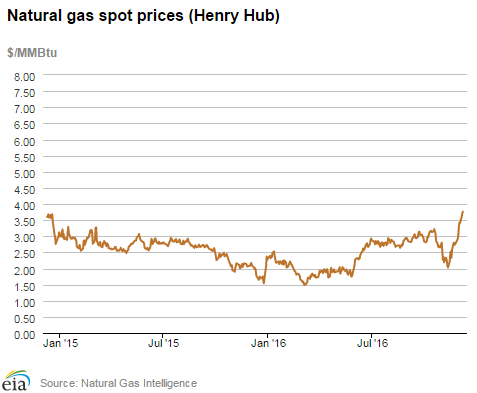
| Spot Prices ($/MMBtu) | Thu, 01-Dec |
Fri, 02-Dec |
Mon, 05-Dec |
Tue, 06-Dec |
Wed, 07-Dec |
|---|---|---|---|---|---|
| Henry Hub |
3.42 |
3.41 |
3.60 |
3.71 |
3.76 |
| New York |
3.06 |
3.29 |
3.63 |
3.63 |
4.13 |
| Chicago |
3.39 |
3.41 |
3.62 |
3.76 |
3.85 |
| Cal. Comp. Avg.* |
3.46 |
3.39 |
3.66 |
3.76 |
3.72 |
| Futures ($/MMBtu) | |||||
| December contract | 3.505 |
3.436 |
3.654 |
3.635 |
3.603 |
| January contract |
3.509 |
3.440 |
3.641 |
3.626 |
3.589 |
| *Avg. of NGI's reported prices for: Malin, PG&E Citygate, and Southern California Border Avg. | |||||
| Source: NGI's Daily Gas Price Index | |||||
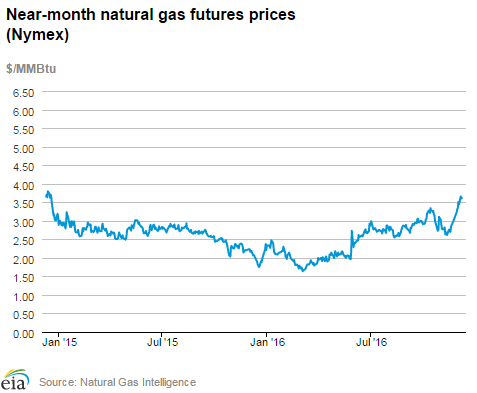
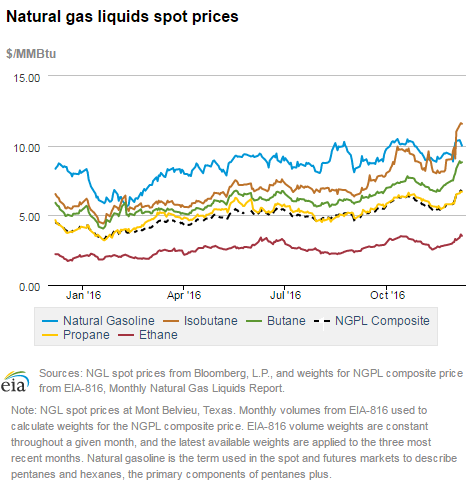
| U.S. natural gas supply - Gas Week: (12/1/16 - 12/7/16) | |||
|---|---|---|---|
Average daily values (Bcf/d): |
|||
this week |
last week |
last year |
|
| Marketed production | 79.9 |
80.7 |
81.8 |
| Dry production | 71.8 |
72.5 |
73.9 |
| Net Canada imports | 5.1 |
4.8 |
5.9 |
| LNG pipeline deliveries | 0.2 |
0.2 |
0.2 |
| Total supply | 77.1 |
77.5 |
80.0 |
|
Source: OPIS PointLogic Energy, an IHS Company | |||
| U.S. natural gas consumption - Gas Week: (12/1/16 - 12/7/16) | |||
|---|---|---|---|
Average daily values (Bcf/d): |
|||
this week |
last week |
last year |
|
| U.S. consumption | 79.6 |
69.0 |
77.3 |
| Power | 23.2 |
21.1 |
24.1 |
| Industrial | 22.4 |
21.6 |
22.0 |
| Residential/commercial | 34.1 |
26.3 |
31.3 |
| Mexico exports | 3.7 |
3.7 |
3.2 |
| Pipeline fuel use/losses | 6.9 |
6.5 |
6.7 |
| LNG pipeline receipts | 1.5 |
1.4 |
0.0 |
| Total demand | 91.7 |
80.5 |
87.2 |
|
Source: OPIS PointLogic Energy, an IHS Company | |||
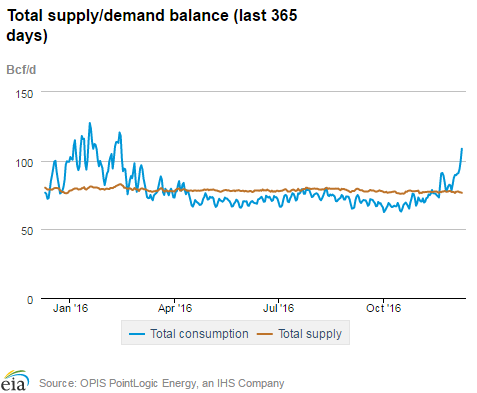
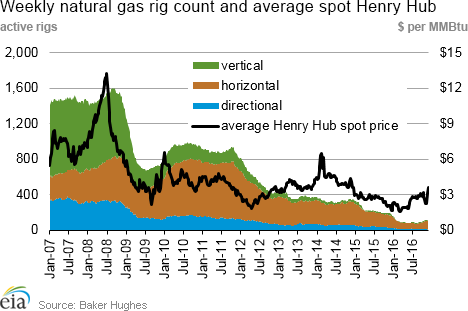
| Rigs | |||
|---|---|---|---|
Fri, February 10, 2017 |
Change from |
||
last week |
last year |
||
| Oil rigs | 477 |
0.6% |
-12.5% |
| Natural gas rigs | 119 |
0.8% |
-38.0% |
| Miscellaneous | 1 |
0.0% |
0.0% |
| Rig numbers by type | |||
|---|---|---|---|
Fri, February 10, 2017 |
Change from |
||
last week |
last year |
||
| Vertical | 66 |
0.0% |
-36.5% |
| Horizontal | 485 |
2.1% |
-14.8% |
| Directional | 46 |
-11.5% |
-28.1% |
| Source: Baker Hughes Inc. | |||
| Working gas in underground storage | |||||
|---|---|---|---|---|---|
Historical comparisons |
|||||
Year ago (2/10/16) |
5-year average (2012-2016) |
||||
| Region | Stocks (Bcf) |
% change |
Stocks (Bcf) |
% change |
|
| East | 583 |
-17.8 |
521 |
-8.1 |
|
| Midwest | 703 |
-8.7 |
585 |
9.7 |
|
| Mountain | 148 |
1.4 |
142 |
5.6 |
|
| Pacific | 256 |
-19.9 |
246 |
-16.7 |
|
| South Central | 1,057 |
-8.3 |
864 |
12.2 |
|
| Total | 2,748 |
-11.0 |
2,358 |
3.7 |
|
| Source: U.S. Energy Information Administration | |||||
| Temperature -- heating & cooling degree days (week ending Dec 01) | ||||||||
|---|---|---|---|---|---|---|---|---|
HDD deviation from: |
CDD deviation from: |
|||||||
| Region | HDD Current |
normal |
last year |
CDD Current |
normal |
last year |
||
| New England | 159 |
-34 |
-7 |
0 |
0 |
0 |
||
| Middle Atlantic | 142 |
-43 |
-3 |
0 |
0 |
0 |
||
| E N Central | 165 |
-47 |
-7 |
0 |
0 |
0 |
||
| W N Central | 181 |
-57 |
-47 |
0 |
0 |
0 |
||
| South Atlantic | 89 |
-38 |
13 |
16 |
6 |
-1 |
||
| E S Central | 105 |
-27 |
42 |
1 |
0 |
0 |
||
| W S Central | 64 |
-32 |
-29 |
9 |
5 |
0 |
||
| Mountain | 199 |
-4 |
-51 |
0 |
0 |
0 |
||
| Pacific | 118 |
13 |
-19 |
0 |
-1 |
0 |
||
| United States | 137 |
-30 |
-13 |
4 |
2 |
0 |
||
|
Note: HDD = heating degree day; CDD = cooling degree day Source: National Oceanic and Atmospheric Administration | ||||||||
Average temperature (°F)
7-Day Mean ending Dec 01, 2016
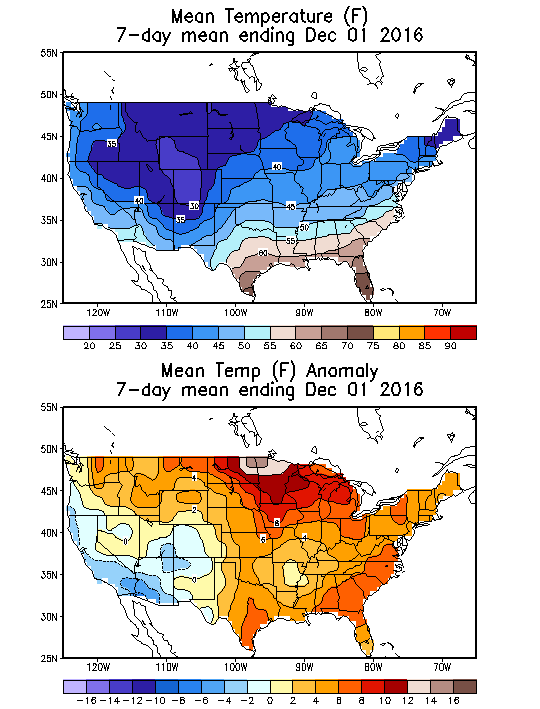
Source: NOAA National Weather Service
Deviation between average and normal (°F)
7-Day Mean ending Dec 01, 2016

Source: NOAA National Weather Service

